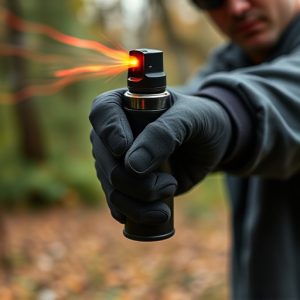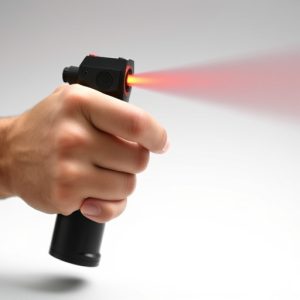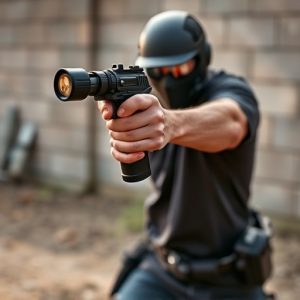Tactical Pepper Spray: Effective Deployment Strategies and Safety Considerations
Tactical pepper spray, a specialized tool for law enforcement and self-defense, uses capsaicin to te…….
Tactical pepper spray, a specialized tool for law enforcement and self-defense, uses capsaicin to temporarily incapacitate individuals without permanent harm. Its deployment methods vary from hand-held aerosol cans to bullet-like rounds and integrated systems in firearms, catering to diverse needs while prioritizing safety and effectiveness. In riot control, tactical teams use these canisters strategically based on distance, wind conditions, spray type, and weather factors, such as humidity and temperature. Common tactics include line formations and targeted spraying, with advanced equipment enhancing accuracy and control. Training and safety protocols are essential for officers to master deployment methods, understand different sprays, and practice real-world scenarios, ensuring effective crowd control while minimizing risks to officers and bystanders.
“Unleashed during law enforcement operations, riot control inflammatory spray canisters are specialized tools designed to disrupt and disperse crowds. Understanding their intricate design and purpose is paramount for optimal tactical deployment. This article delves into the strategic deployment methods of these canisters, exploring factors influencing range and safety. We dissect common types, highlighting unique features, and emphasize training and safety protocols crucial for law enforcement agencies. Discover expert insights on tactical pepper spray deployment methods for effective crowd control.”
- Understanding Riot Control Spray Canisters: Their Design and Purpose
- Tactical Deployment Strategies for Optimal Effectiveness
- Factors Influencing Range and Safety During Use
- Common Types and Their Unique Features
- Training and Safety Measures for Law Enforcement Agencies
Understanding Riot Control Spray Canisters: Their Design and Purpose
Riot control spray canisters, often referred to as tactical pepper spray, are specialized devices designed for law enforcement and self-defense purposes. These canisters are equipped with a powerful irritant, usually capsaicin, which is known for its effects in disrupting visual and olfactory senses, temporarily incapacitating individuals without causing permanent harm. The design focuses on ease of deployment and reliability in high-pressure situations.
The purpose of these canisters extends beyond just riot control. They are also employed in close-quarters combat scenarios, providing a non-lethal means to subdue aggressors or intruders. Various deployment methods exist, including hand-held aerosol cans, bullet-like rounds for long-range use, and even integrated systems within firearms. These tactical pepper spray deployment methods cater to different law enforcement needs, ensuring officers have the right tool for the situation while prioritizing safety and effectiveness.
Tactical Deployment Strategies for Optimal Effectiveness
In tactical situations, effective deployment of riot control inflammatory spray canisters relies on strategic planning and precise execution. Law enforcement agencies often employ specialized units trained in crowd control, utilizing various tactical pepper spray deployment methods to maintain order while minimizing harm. One common approach is the ‘line formation’, where officers form a barrier, directing the spray towards the crowd’s path of advance. This method ensures maximum coverage and can deter aggressive behavior by creating a physical and sensory obstacle.
Another tactic involves targeted spraying, focusing on specific individuals or groups within the crowd who are causing disruptions. This strategy requires quick assessment and accurate aim to disrupt troublemakers without affecting bystanders. The use of specialized equipment, such as long-range spray guns or advanced canisters with adjustable mist settings, enhances accuracy and control over the situation.
Factors Influencing Range and Safety During Use
The range and safety of a riot control inflammatory spray canister are influenced by several tactical pepper spray deployment methods and environmental factors. One key consideration is the distance at which the canister is deployed. Different scenarios require varying distances; close-quarters combat necessitates precise, short-range applications for maximum impact, while crowd dispersion may demand longer-range shots to ensure safety of both officers and civilians. Wind conditions also play a critical role in determining the effective reach of the spray. Understanding how wind direction and speed can alter particle trajectory is essential for strategic deployment, minimizing off-target effects and ensuring the safety of bystanders.
Another factor is the type of pepper spray used, as different formulations have varying properties that impact range and effectiveness. The concentration of capsaicin or other active ingredients affects both the distance at which the spray can reach and its overall potency. Additionally, weather conditions, such as humidity and temperature, can influence the spray’s behavior. Moisture in the air may affect the spray’s evaporation rate, while high temperatures can reduce the effectiveness of the pepper spray over time. Knowing these variables allows tactical teams to adjust their deployment methods accordingly for optimal results while prioritizing safety during riot control operations.
Common Types and Their Unique Features
In the realm of riot control, one of the most common tools employed is the inflammatory spray canister. These devices come in various types, each with unique features tailored to different tactical situations. Among them, Tactical Pepper Spray stands out for its ability to disable aggressors by inducing a burning sensation and temporary blindness. This type often utilizes oleoresin capsicum (OC), a natural compound derived from chili peppers, making it a popular choice for law enforcement agencies due to its effectiveness and relatively low risk of serious injury.
Another notable variant is the CS gas canister, filled with 1,3-dichloropropene, which irritates the eyes, nose, and throat, leading to temporary incapacitation. Unlike pepper spray, CS gas is non-flammable but still potent. Some advanced models incorporate deployment methods like aerosol canisters designed for rapid and even dispersion, ensuring maximum coverage during high-stress scenarios. These tactical considerations make each type of inflammatory spray canister a valuable asset in managing civil unrest or securing crowded venues, demonstrating their versatility and importance in modern law enforcement strategies.
Training and Safety Measures for Law Enforcement Agencies
Training and safety measures are paramount for law enforcement agencies when it comes to using riot control inflammatory spray canisters, also known as tactical pepper spray. Officers must undergo comprehensive training on various deployment methods, understanding the different types of sprays, and mastering the technique to ensure effective and safe use. This includes practicing scenarios that mimic real-world situations, learning how to assess crowd dynamics, and developing strategies for controlling unruly gatherings.
Safety is a primary concern, with agencies emphasizing responsible usage and de-escalation techniques. Officers are taught to minimize exposure to the spray themselves while protecting bystanders. Regular maintenance of equipment and familiarity with safety protocols are also critical, ensuring that every deployment is conducted with precision and caution.
Riot control spray canisters, with their strategic deployment methods (Tactical Pepper Spray Deployment Methods), serve as powerful tools for law enforcement agencies. Understanding their design, purpose, and various types ensures optimal effectiveness while mitigating safety risks. Effective training and adherence to safety measures are paramount to harnessing these tools’ potential without endangering civilians or officers. By navigating the factors influencing range and safety, law enforcement can navigate challenging situations with confidence and control.


